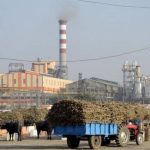WEEKLY COMMENT – JUNE 28TH TO JULY 2ND,2021
FROST AS A BACKDROP
The sugar futures market in NY closed out the week with a huge quotation appreciation. The first contract listed, now for October/2021 after a dull, odorless and colorless physical delivery in July, closed out at 18.21 cents per pound, increasing 155 points, 34 dollars equivalent per ton, against the previous Friday. In real, the increase came close to R$140 per ton, also contaminating the average of the next 2022/2023 (going up 70 real per ton) and 2023/2024 (55 real per ton) crops – a great opportunity to fix prices.
The concern over the effects of the frost that hit the producing regions last week is the backdrop for this excessive rise. However, nine out of ten mill owners consulted ruled out any meaningful damage to the sugarcane fields because of the cold weather. “Just a few lowlands were affected”, an executive told me. “Since only 35% of the sugarcane has been cropped so far, any affected area would still have enough time to bounce back. Should we have a frost late August (with this same profile), then it would be risky because it would harm next crop’s sugarcane”, he concluded.
For the funds, the anxiety on the market caused by the frost news prompted speculative purchases that put the futures in NY at record levels (18.49 cents per pound on Thursday). But some things still don’t make sense. The funds are long in October, which is at a discount compared to the next maturity (March/2022). I suspect that the funds will take advantage of this period (until about mid-September), when quotations seasonably are pressed by the weight of the crop, and will start settling their long positions. Let me explain: the speculative funds seldom stay long in a cash and carry market.
Note that coffee – a much more sensitive commodity to low temperatures – closed out the week at a more than 2% low. That might mean that a lot of speculators rushed things and got disappointed with the weak effect the cold weather had on the coffee crops. Sugar, produced by a grass much more resistant to low temperatures than Rubiaceae, went up 1.5%. That is, the argument that the market went up due to the cold weather has the same consistency as Jello-O.
Looking at UNICA’s numbers, though the crushing might surprise negatively, because in the accumulated the volume of crushed sugarcane is almost 12% lower than that of the same period last year, the positive surprise comes from ATR which should be way higher than the 2020/2021 crop on average, but which points to a sugar production which will be between 3.25 and 4.0 million tons below the past crop. This number is in line with market forecasts.
I still believe that NY sugar prices in real per ton over the short-term should decrease and, though there is little volume left to be fixed against the 2021/2022 crop, the recommendation is still the same, which is, fix prices in real per ton and wait on better prices in cents per pound for the next crops, because the scenario is positive due to the questions we discussed here in the last comments: stagnation of sugarcane production in the Center-South, India reverting part of its production to ethanol, post-pandemic world consumption recovery, improved per capita consumption in Asia, among other things.
After trading with premium on NY sugar for some time, hydrous ethanol closed out the week, B3 base with an average discount of 100 points. Gas (Petrobras price) is out of step with the international market (about R$0.30 per liter). It remains to be seen whether the state-owned company will hold the price or will pass it on over the next days.
June ended with the average sugar closing in NY at 17.23 cents per pound – 3 points better than that seen in May and 9 points above what our model was showing. But, here’s some good news for the bulls: this same model shows that July’s average, based on the 20-year curve, should be 17.98 cents per pound. I have quite a few doubts about this possibility. However, to reinforce the argument of the model, over the last 20 years, the average price for July has been greater than the average price for June 15 times. Will that happen again? -make your bets.
For the bears, here goes a good argument they should be aware of. Over the only four times when in the first semester June has had the highest average of the period, just like now, the year ended with the market creating new highs in the second semester.
The non-index funds increased the long position over the week (Tuesday against Tuesday) by 5,500 lots. Now they are long by a total of 190,500 contracts, but everything suggests that the volume on Friday might have gone beyond 200,000 contracts.
Next week will be shorter due to the American Independence Day holiday.
Click here to read Episode 1
Click here to read Episode 2
Click here to read Episode 3
Click here to read Episode 4
Click here to read Episode 5
Mr. Arnaldo Luiz Correa is the Director at Archer Consulting. He is a Risk Manager with an experience of almost 30 years in the agriculture commodities market.
To get in touch with Mr. Arnaldo, write on arnaldo@archerconsulting.com.br












